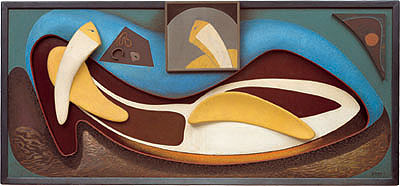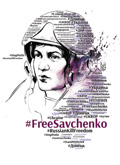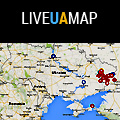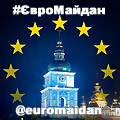BRAMA, Mar 23, 2005, 9:00 am ET
Press release
Alexander Archipenko Exhibition to Inaugurate New Ukrainian Museum Building
New York City — The new facility of The Ukrainian Museum in New York City will open on April 3, 2005, with the inaugural exhibition Alexander Archipenko: Vision and Continuity, consisting of some 65 sculptures and sculpto-paintings of one of the 20th century's most innovative and influential artists.
 Alexander Archipenko
Alexander Archipenko
Cleopatra
1957, wood, bakelite and found objects
38 in. x 84 in. (96.5 x 213.3 cm)
On loan from Frances Archipenko Gray
|
The majority of the works are from the collection of Frances Archipenko Gray, the artist's widow. Other works come from a number of private collections and museums, including the Brooklyn Museum, the Solomon R. Guggenheim Museum, the Hirshhorn Museum and Sculpture Garden, the Metropolitan Museum of Art, the Whitney Museum of American Art, and the Yale University Art Gallery.
|
Alexander Archipenko:
Biographical Notes
The subject of the new Ukrainian Museum's inaugural exhibition is Alexander Archipenko (1887-1964), one of the 20th century's leading and most innovative sculptors.
Archipenko was born in Kyiv, Ukraine, where he studied painting and sculpture at the Kyiv Art Institute until 1905. The following year, he moved to Moscow, where he participated in exhibitions and where he was exposed to a large exhibition of French art at the Golden Fleece Salon of 1908. Later that year he relocated to Paris, then in the throes of an artistic revolution led by Pablo Picasso and Henri Matisse.
Archipenko quickly established a reputation for brilliant innovation. His exploration of convex/concave forms, volume/space transference, the reintroduction of color to sculpture, his mixed-media constructions, and his invention of sculpto-painting solidified his reputation as the most important sculptor of the time. Archipenko's position was validated by an exhibition of his works at the 1920 Venice biennale, then the highest honor accorded a living artist.
In 1921 Archipenko moved to Berlin, where he opened an art school and also began experimenting with naturalism. The same year, he married the sculptor Angelica Bruno-Schmitz.
In 1923 Archipenko moved to the United States, where he remained for the rest of his life. In 1929 he purchased a stone quarry in Bearsville, New York, which became his home, studio, and art school.
In his forty-year career in America, Archipenko traveled widely. He taught in numerous colleges and universities from coast to coast, opened an art school in Los Angeles in 1935, and in 1937 taught at the New Bauhaus in Chicago. He participated in such seminal exhibitions as the Museum of Modern Art's Cubism and Abstract Art, curated by Alfred H. Barr, Jr., in 1936. He continued to create such celebrated works as Torso in Space (1935).
Archipenko also pursued his innovations in America. In 1927 he was granted a patent for his invention entitled Archipentura, a motorized structure that allowed painted images to move. He experimented with new materials like formica and bakelite. In his works in Plexiglas from the 1940s, he also experimented with illumination.
In the 1950s, Archipenko's most important and productive period since his Paris years, he returned to sculpto-paintings in which he used the new materials. His masterpiece from this period is the sculpto-painting Cleopatra (1957), the artist's largest work in this medium. During these years he was represented by the Perls Gallery.
|
Alexander Archipenko (1887-1964) was born in Kyiv, Ukraine, where he studied art at the Kyiv Art Institute until 1905. In 1906 he moved to Moscow, and in 1908 to Paris. Archipenko established his reputation as a revolutionary innovator in the art world of Paris in the first decades of the 20th century, working in the milieu of artists like Pablo Picasso, Henri Matisse, and Constantin Brancusi. In 1921, Archipenko moved to Berlin, and in 1923 he came to the United States, settling in Bearsville, New York (near Woodstock). He remained in America for the rest of his life -- a forty-year period of prodigious creative output. Archipenko was an important pedagogue and ran his own art school. He also taught and worked in many institutions of higher learning from coast to coast as well as in the New Bauhaus in Chicago.
Dr. Jaroslaw Leshko, Professor Emeritus of Art History at Smith College in Northampton, Massachusetts, is the curator of the Alexander Archipenko exhibition and the author of the comprehensive analytical essay in the exhibition's fully illustrated, bilingual (English-Ukrainian), 180-page catalogue. Professor Leshko has organized the exhibition around four dominant concepts: Form and Space; Motion and Stasis; Construction, Materials, Color; and Content into Form. "This approach allows the visitor to explore vital continuities in Archipenko's art," says Professor Leshko, "since each of these rubrics was revisited and reinterpreted in every phase of his career." It also allows for striking juxtapositions across time, underscoring a continuous, evolving artistic vision.
Form and Space. Archipenko's greatest and best-known contribution to the vocabulary of modernism lay in his reassessment of the relationship between solid and void, notes Professor Leshko. "This manifested itself in the exploration of concave/convex forms, and especially in his substitution of a void for a head or a torso -- his most important and radical innovation," he adds. "Archipenko would continue to explore the concave/convex, solid/void relationship in brilliant permutations throughout his career." Some of the artist's most important works belong in this category: Silhouette (Woman with Umbrella) (1913), Geometric Statuette (1914), Woman Combing Hair (1915), Green Concave (1913-15), Flat Torso (1914), Walking (1912-18), Seated Woman (1920).
In the later phase of his career, Archipenko consistently utilized the concave/convex motif, and the solid/void transformation also continued to inform his vision. Seated Figure (1947), Oval Figure (1957), and Queen of Sheba (1961) are compelling examples of his later exploration of the void.
Motion and Stasis.
Archipenko's interest in movement dates back to the outset of his career. It reflects a general interest at the time in defining modernity through motion. According to Professor Leshko, "it also speaks of his restless, inventive temperament, fascinated with the vitality and variety of human form in motion."
Dance (1912-13), Blue Dancer (1913), Boxers (1914), and Walking (1912-18) are among Archipenko's most important early examples of motion in sculpture. Walking as a motif recurs in every decade of his career, each time brilliantly transformed.
These works have a counterpoint in Archipenko's imagery of stasis that is, in Professor Leshko's words, "still, iconic, and contemplative." Works like Vase Woman I (1918), Torso in Space (1935), and Dignity (1961) belong to this group. In certain works both motion and stasis are implicit, as in Penchй (1913) and Gondolier (1914). Revolving Figure (1956) is a literal translation of this idea.
Construction, Materials, Color.
Archipenko's challenge to the process of sculpture and its traditional materials was boldly announced in his construction Mйdrano I (1912-14). His fascination with various materials startlingly juxtaposed continued and evolved throughout his career, constantly incorporating new processes and materials like plastic, bakelite, and formica. Woman Standing (1920) and Woman (Metal Lady) (1923) are important examples. His later works include Seated Figure (1947), Oval Figure (1957), White (1957), and Cleopatra (1957).
"No other sculptor of the 20th century involved color in his imagery as insistently and consistently as Archipenko," Professor Leshko points out. Carrousel Pierrot (1913) is an early, brilliant example of orchestrating color through form and form through color. He invented a new category of sculpto-painting to investigate the symbiosis between painting and sculpture. Bather (1915) and Woman with Fan (1915) are early examples. He revitalized the art of painted wood and terra-cotta in such compelling works as Architectural Figure (1950).
Content into Form.
Archipenko's revolutionary innovations are manifest in a context of rich and varied content. In his works he explores extensively the world of entertainment from circus to boxing to dance in works like Mйdrano I (1912--14), Mйdrano II (1913), Boxers (1914), and Dancers (1912). He addresses historical figures like Cleopatra (1957) and Queen of Sheba (1961). He taps into a rich emotional vein in works like Sorrow (Tristesse) (1909), Feminine Solitude (1921), Mв-Meditation (1932), and Dignity (1961). He also touches on religious themes like Adam and Eve (1909) and Ascension (1950). These examples are indicative of Archipenko's broad range of interests and their central role in his creative expression. Archipenko's extensive writings on art underscore the theoretical and philosophical underpinnings of his innovations.
As its title implies, Alexander Archipenko: Vision and Continuity demonstrates the sustainability of the artist's vision and reiterates that he stayed true to his core principles throughout his life. Adds Professor Leshko: "The exhibition affords visitors an opportunity to explore and experience the creative breath and sheer beauty of the art of one of the 20th century's most influential and innovative sculptors."
The Ukrainian Museum has organized a variety of public programming to augment the Archipenko exhibition, including tours, gallery talks, a lecture series, a symposium, and a full range of educational material for teachers, students, and young families.
After completing its run at The Ukrainian Museum on September 4, 2005, the exhibition will travel to the Smith College Museum of Art (March 31 to July 30, 2006) and to the Elvehjem Museum of Art in Madison, Wisconsin (September 16 to December 3, 2006).
The Alexander Archipenko exhibition is the first of three inaugural exhibitions planned for the new Ukrainian Museum building -- a state-of-the-art, 25,000-square-foot, $9 million facility at 222 East 6th Street in the heart of the East Village.
|
 Alexander Archipenko
Alexander Archipenko





